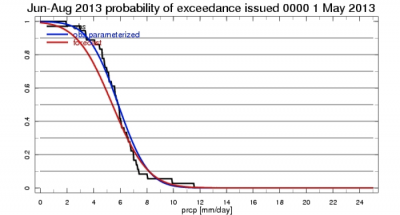Tool to help analyse rainfall variability in South Asia now available

by Alexa Jay and Gopal Datt Bhatta
South Asia has historically been characterized by the dominance of smallholder, rainfed agriculture. Increasing climate variability creates yearly fluctuations in production that adds new risks to farming systems.
Precipitation is a very important component for agriculture in the region. The region has relatively low-to-moderate seasonal forecast skill during summer. It is however very crucial to assess seasonal predictions and inform the design of actionable seasonal climate information for rural communities to meet the associated risks.
The predictability of climate variables at the seasonal timescale, such as expected total rainfall, is one important foundation for climate information services. However, the most relevant information for farmers often goes far beyond seasonal rainfall totals, extending to information such as the date of monsoon onset or the number of dry spells during the rainy season.
CCAFS Theme 2, Adaptation through Managing Climate Risk, is working to protect and enhance food security in a changing climate by supporting the development of climate information tools tailored specifically to the needs of agriculturalists.
Beginning in 2011, a CCAFS Theme 2 project at the International Research Institute for Climate and Society developed an online tool, to aid analysis of rainfall variability and seasonal predictability at CCAFS benchmark sites in South Asia.
Researchers found a promising degree of predictability of summer monsoon rainfall at sites in India and Nepal, opening up possibilities for developing more carefully tailored information for agricultural users in the region.
Rainfall over the Northern India-Nepal-Bangladesh region is concentrated in the summer monsoon season. In a region where rain-fed agriculture is prevalent, yearly shifts in the strength and timing of the monsoon can have major consequences for food security.
Despite challenges in predicting seasonal total rainfall, certain characteristics of seasonal rainfall that are important for agriculture, including the number of dry days during the monsoon season and the monsoon onset date, are sometimes more predictable than the seasonal rainfall total itself.
Updates to the tool take advantage of a higher resolution precipitation dataset, allowing users to calculate historical daily weather statistics by season across Nepal, Bangladesh and Northern India. Users can define a temperature threshold, such as the level at which the productivity of a particular crop begins to decline, and calculate how often it is normally exceeded in a season.
Users can also assess the probabilities of above-normal, near-normal, and below-normal rainfall and temperature during each state of the El Niño/Southern Oscillation cycle, which can have a significant impact on the strength and timing of the South Asian monsoon. Seasonal forecasts based on state-of-the-art general circulation climate models are available, along with an illustration of model skill over different areas. An experimental downscaled forecasting tool provides a higher resolution prediction of seasonal total rainfall.
This research provides a more complete picture of how rainfall predictability maps onto important agricultural areas in South Asia, and advances the tailoring of climate information for agriculture. Ongoing work will seek to collaborate more closely with users in the region to refine the tools and better support their information needs.


Tailored climate information is only one piece of the efforts to successfully deliver actionable climate services for farmers. Find out more about CCAFS efforts to make climate services more useful for farmers:
How useful is climate information to smallholder farmers in India?
Equity and capacity building: key when scaling-up climate services
This story was prepared by Gopal Datt Bhatta, climate consultant and Alexa Jay, Program Officer for Theme 2: Adaptation through Managing Climate Risk.


